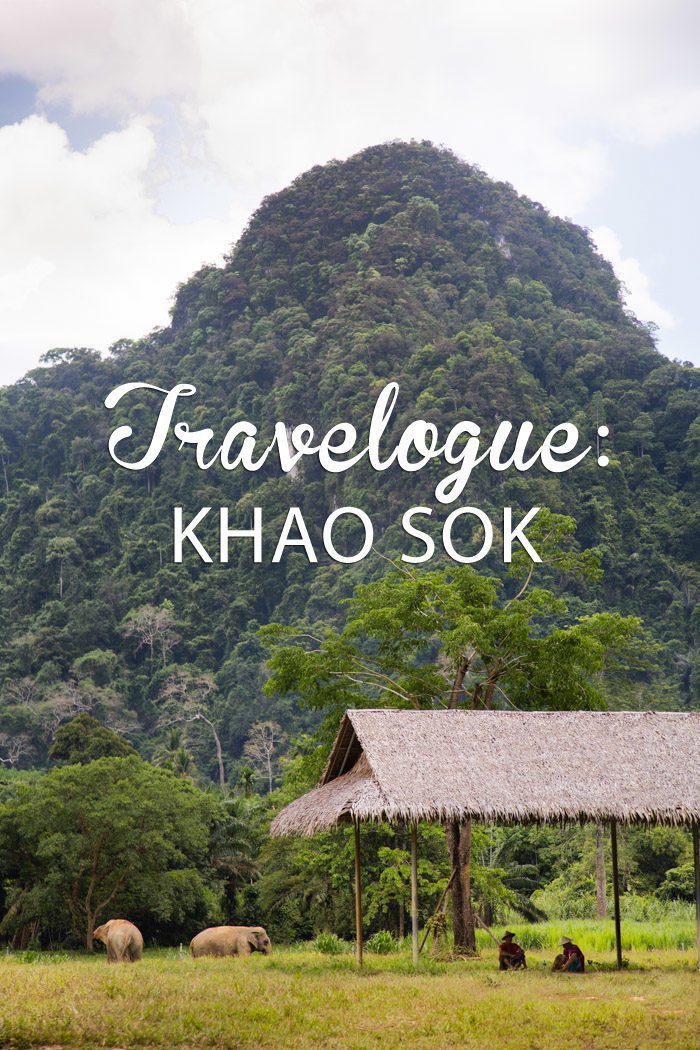
I think I may have been more excited than the kids about the next stop on our trip—where we were going to see elephants!
We were to fly south an hour from Bangkok to Surat Thani and find a van waiting to take us to Elephant Hills Camp in the Khao Sok National Park, the oldest evergreen rainforest anywhere. It’s a beautiful part of the country, with huge towers of limestone, deep valleys, waterfalls, and beautiful lakes. And though elephants were all we were guaranteed to see, the National Park is one of the most biodiverse places in the world, home to over five percent of the world’s species—with tons of insects, birds, and bats, various primates, deer, bear, and even tigers.
We spent two nights there at the camp, but one could easily plan a much longer stay, hiking its trails and exploring its dense jungle in hopes to catch a glimpse.

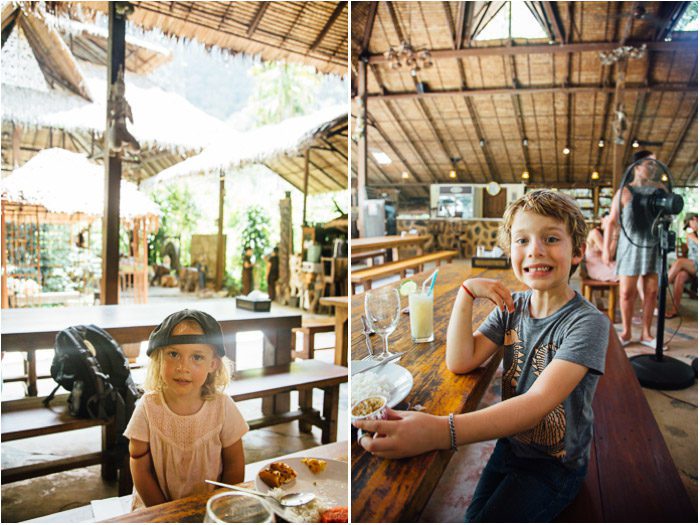
Even though it was a brief portion of our trip to Thailand, our visit to Khao Sok probably required the most preparation. For one thing, there are some terribly sad and inhumane elephant encounter setups in Thailand. One really has to do his or her homework when choosing one. We wanted to find elephants that were cared for properly, with room to roam, who were not performing in shows or giving rides. My understanding is that the most ethical places will not feature interaction with any baby elephants or offer any treks.
There are a few refuges in Thailand that are working to balance the needs of the elephants, their mahouts, and tourism (as those dollars, while potentially problematic, are necessary for care and maintenance of the current elephant population). Of the ones that would fit into our itinerary, we heard the most good things about Elephant Nature Park/Elephant Haven, Boon Lott’s, and Elephant Hills, but here’s a list if you’re looking.
Also, adding Khao Sok to our itinerary meant that we would be traveling in a malarial zone, so we needed to take extra precautions. We spoke with our pediatrician and a travel doctor before the trip and made sure we had appropriate repellants and prophylaxis, as well as up-to-date immunizations for all of the trip. We had pre-treated all of our clothes with permethrin before leaving, and we used Picaridin (rather than Deet) for daily protection. I’m happy to say that we were virtually bite-free.
When it came to getting there, however, the camp took care of most of the details. They suggested an early morning flight out of Bangkok that would get us to the Surat Thani airport for a 9:30am pickup. From there it was about an hour-and-a-half ride to the camp.
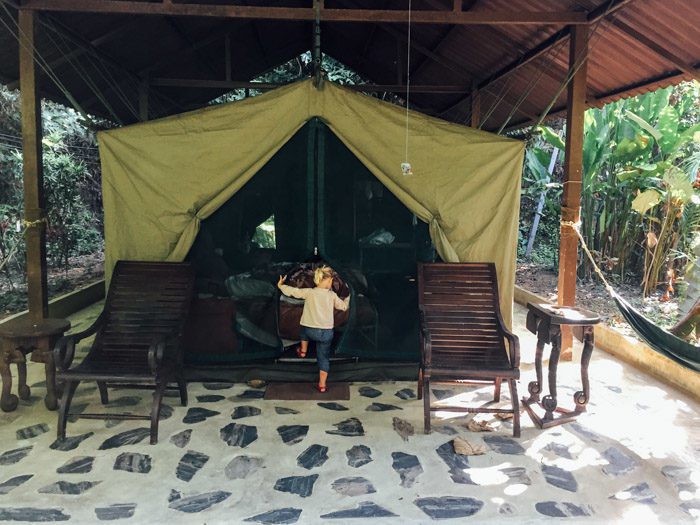

We’d signed up for their three-day jungle safari stay, which included two nights at the main base—where there are about 30 tents, a central dining area, and swimming pool—and a daytrip to Cheow Larn Lake. Many people who come decide to stay one of their nights on the lake, in floating tents (the “rainforest camp”), but our kids were too young for sleeping on the water. We didn’t mind that—I don’t think we’d get any sleep if there were such risk right outside the door.
The tent was really exciting for the kids. All four of us would be snug together—Skyler in our bed and Hudson in a rollaway added later to one side. It was really hot when we first stepped inside and we were concerned we’d miss the A/C, but it really felt cool enough at night with a fan blowing. There was just enough jungle around us for them to go outside and disturb ant trails, hunt for snails and shells that resembled “the heart of te fiti” (Moana, anyone?), and listen to the frogs and birds and the buzz of cicadas all the while.
We were a bit on edge at first, however, listening to their loud, happy calls (“Daddy! I found another snail!” “Momma! A lizard! Momma! Come look!”) and realizing we had no solid walls to keep them from other visitors. Knowing that sometimes the sounds of admonishing parents can be more annoying than the sounds of excited children, however, we did our best to use hand signals. Our wild gesticulations surely looked crazed.
We hoped we would encounter other children staying there, but unfortunately none were scheduled during our stay. The website advises that guests be over the age of four, so Skyler was definitely younger than usual. There were a few young couples, perhaps on a honeymoon, but mostly older adults whose children had grown, or who had left their kids back home with grandparents. And most were from places other than America (primarily the UK), so their kids are probably quieter anyway. All this to say that we had a hard time relaxing there, but in fact our kids did a great job. They were really well-behaved and just so enthusiastic—which I gathered was actually often appreciated.
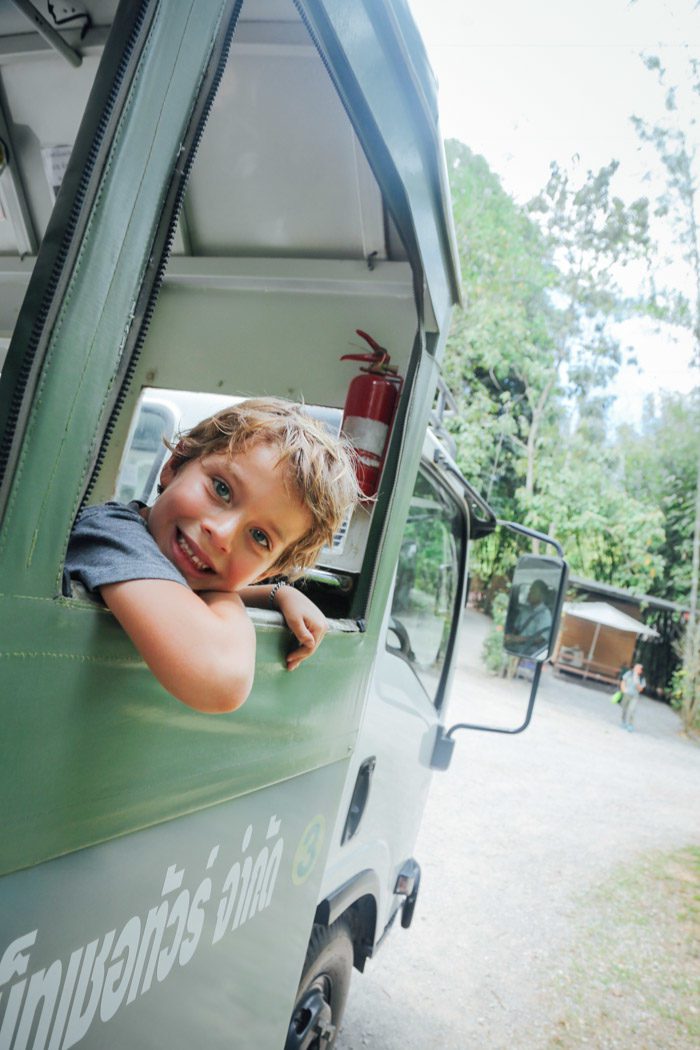
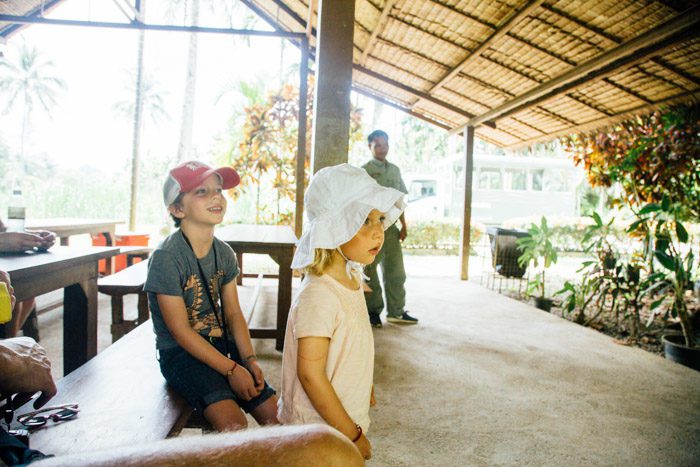
After some time to settle in, have lunch (Aron got a foot massage), meet the giant toad who seemed to live under the dining table, go for a swim, and get bug-lotioned up, we met our guide for our stay. Bamboo is the name she gave us (though I’m guessing the real name is harder for our western tongues), and the kids adored her. They were drawing pictures and writing her notes by the time we left. Our group would go directly to the elephant encounter, and then to a nearby river for a canoe trip—both a short drive away.
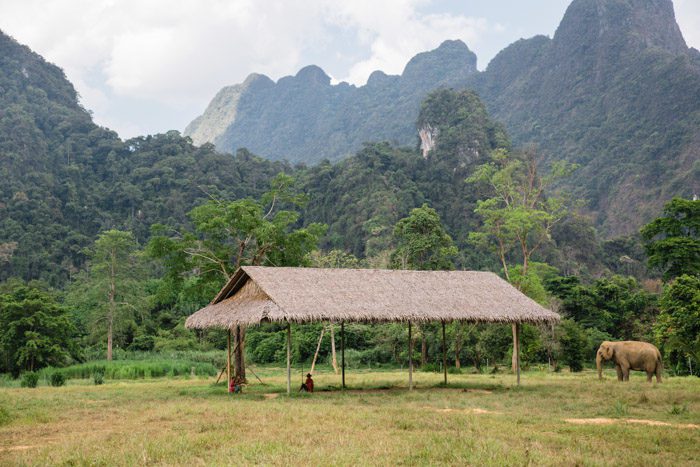
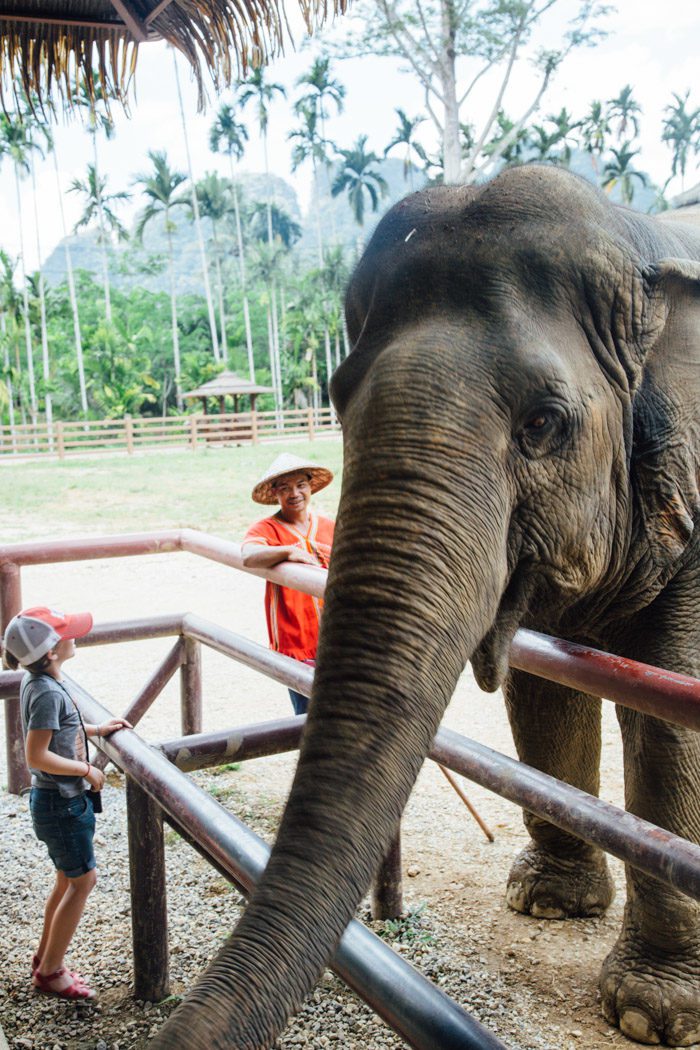
As soon as we arrived, we saw the first elephants out in a large green field, dusting themselves and slowly gliding through the grasses. Down a dirt road, we walked to a thatched-roof enclosure with some barriers for meeting the herd—and later, for feeding them. After some instructions about how to approach and behave with the elephants, we got to watch them play in the water.
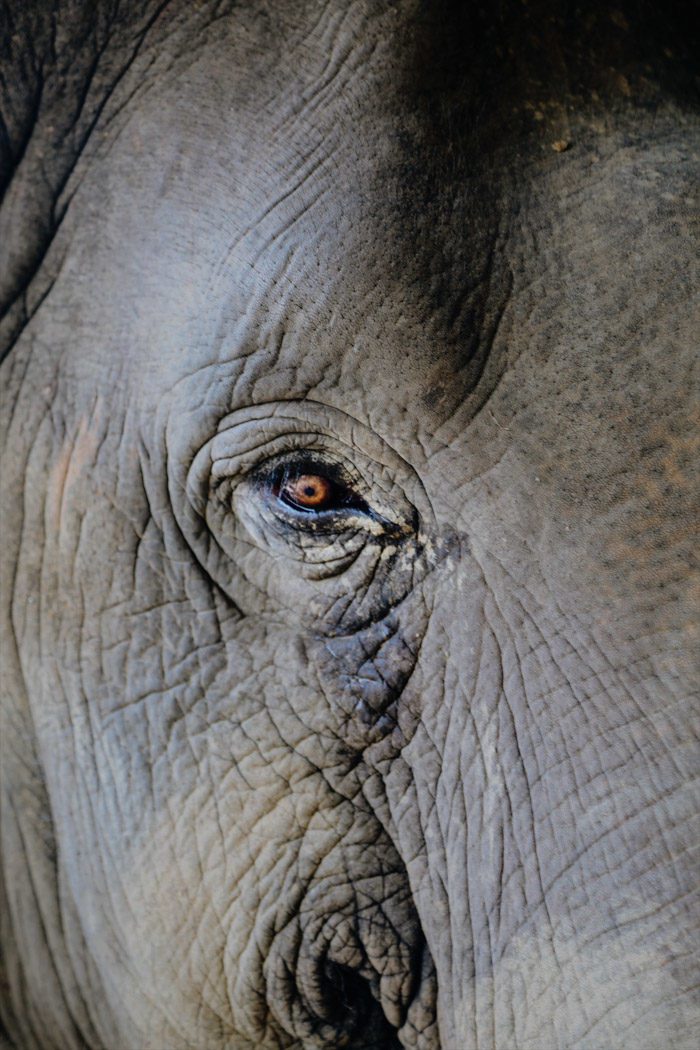
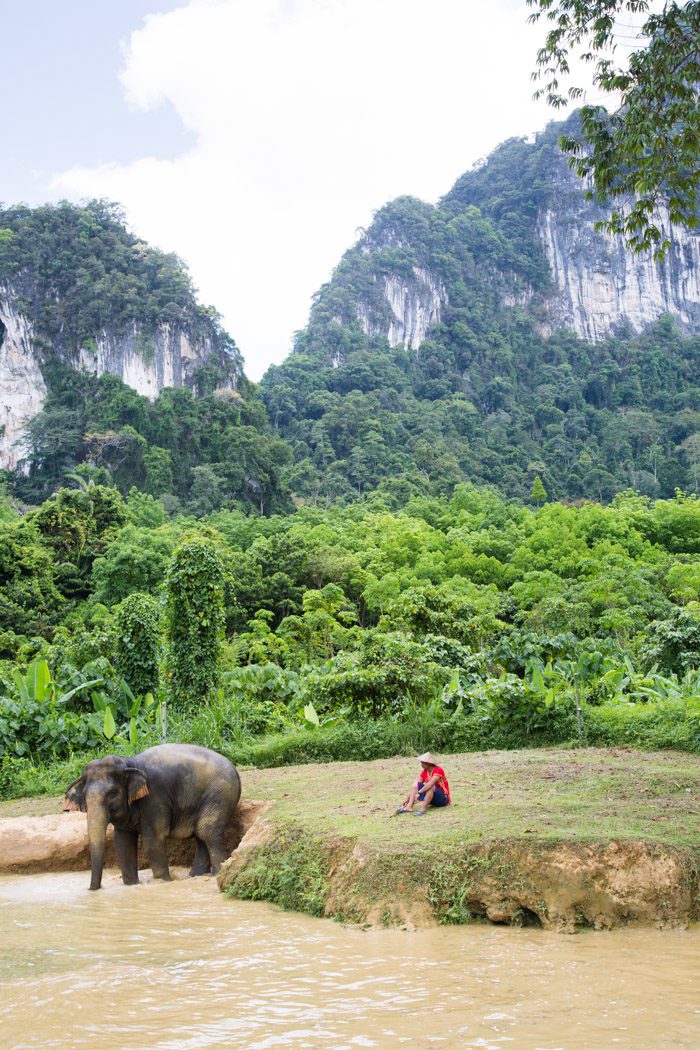
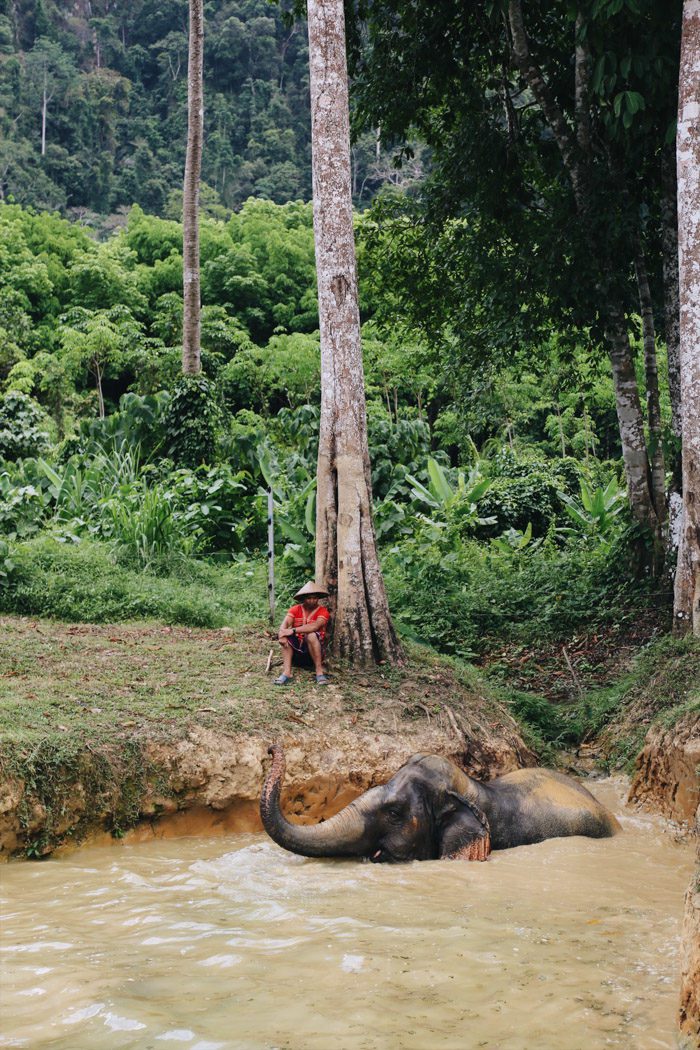
They seemed to be having a wonderful time, scrubbing themselves against the mud and rolling in the water. It’s just incredible to see such huge animals ease into the water and roll about, displacing it in giant waves with just the splash of their trunk. I could have watched them for hours. The kids, however, were equally taken with the small blue dragonflies darting around their feet.
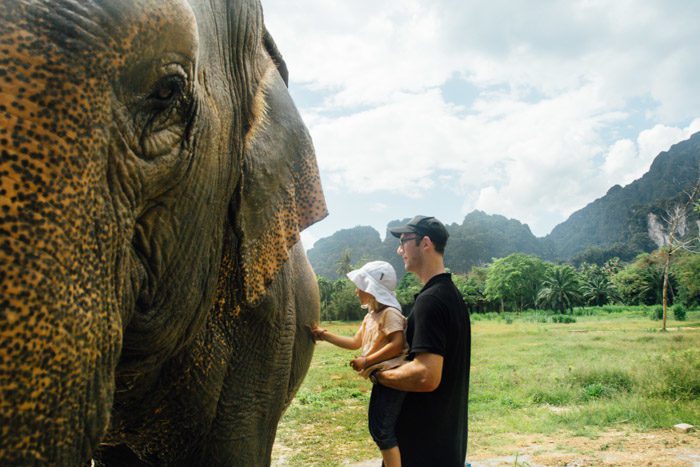

After their mud bath, we each joined one mahout and one elephant to get up close and give them another bath with a hose, a bucket, and some little scrubs made from coconut husks.
At first, Skyler wanted to hang back, but then she surprised us by going in for a hug and a kiss!
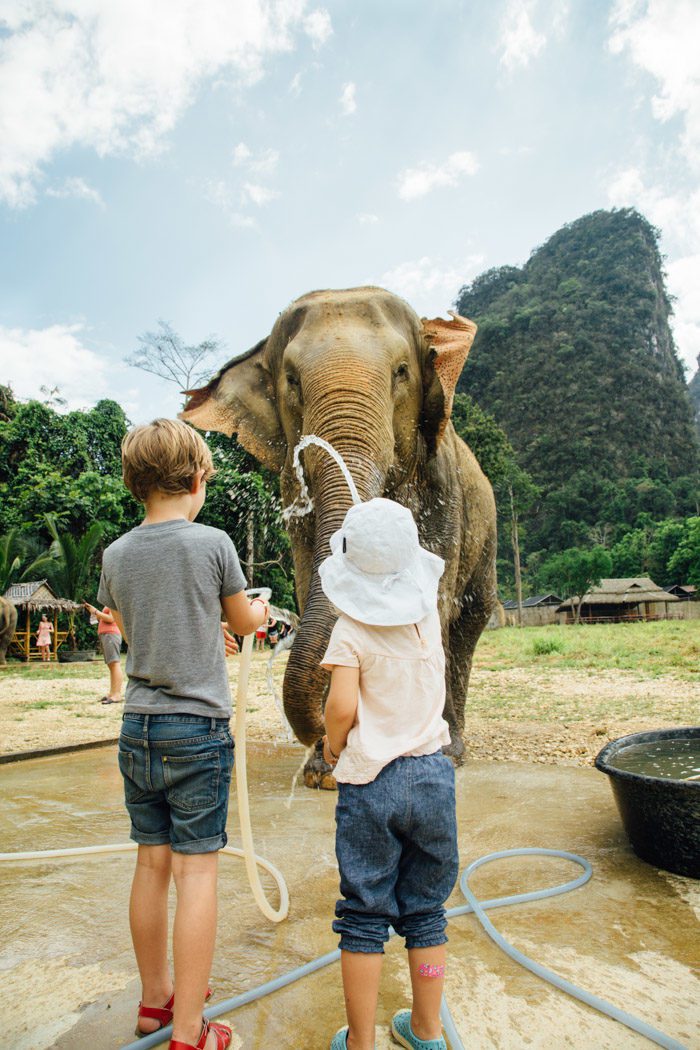
We all got very wet, and didn’t mind at all. Hudson preferred to fill a small pail and dump it onto the elephant, who would then fill her trunk from the hose and use it to spray her own underbelly. It was the coolest. As Aron later put it, you had to stop yourself every few minutes just to take it in and remind yourself that you’re really bathing an elephant. “And what’s the right balance between stopping to take pictures and being in the moment? Do you just help your kids or do you push them aside to do it yourself because it’s so cool?” he said with a laugh.
I noticed later that the elephants picked up some dirt and grasses almost immediately afterward and showered themselves with it, like a fresh application of sunscreen.
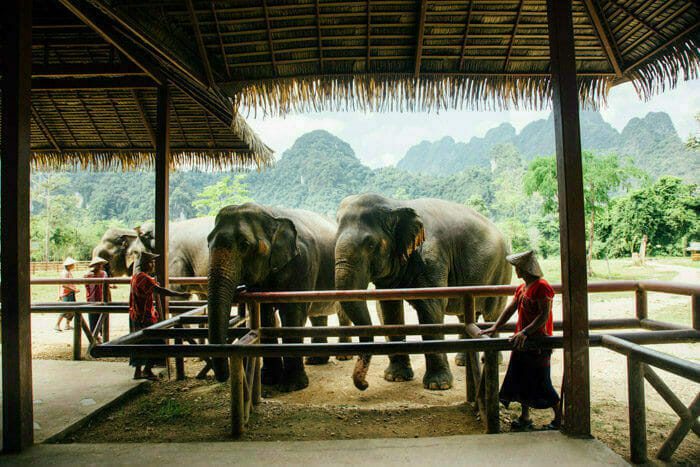
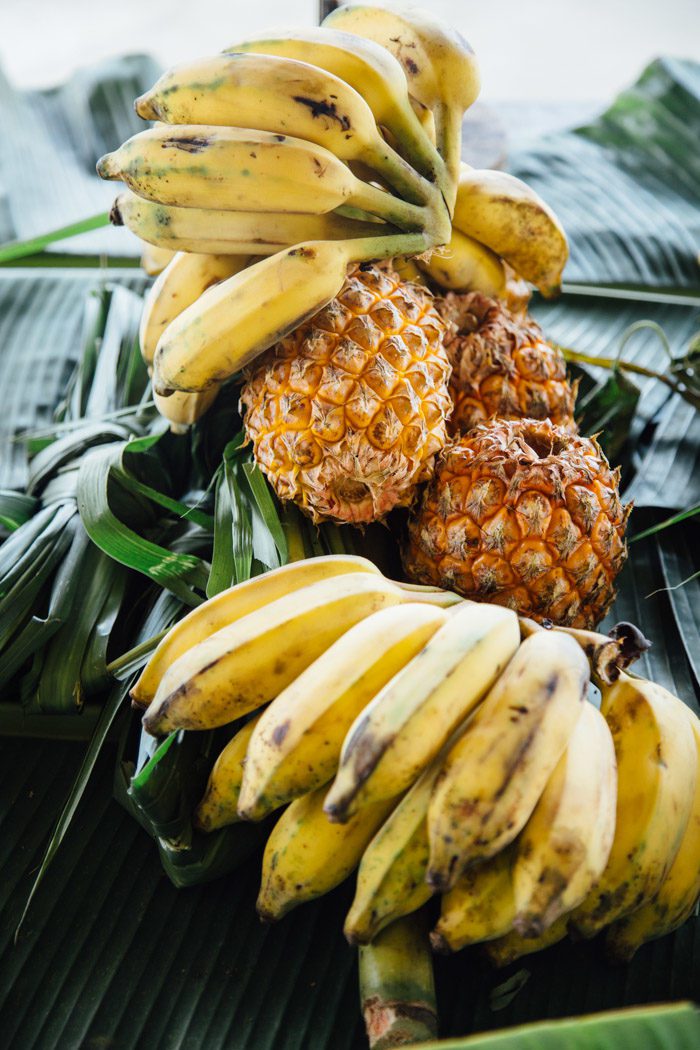
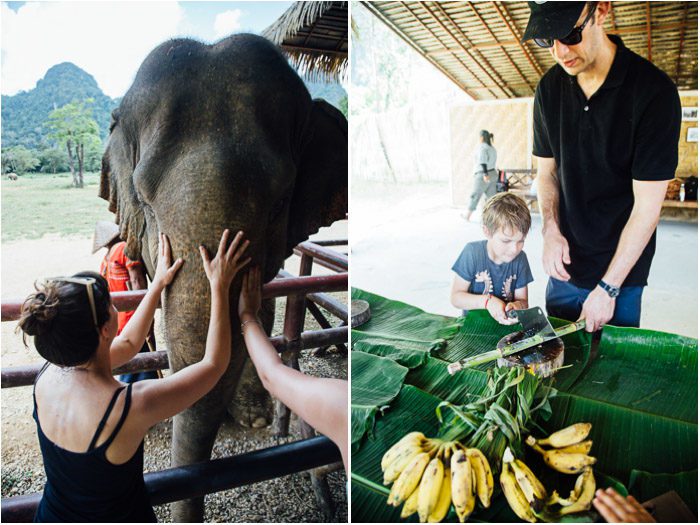
After bathtime, we all headed back over to the tented area to wash up and prepare some snacks. We cut up treats like bananas, pineapples, and sugarcane, and also some tamarind paste rolled in seeds and coconut wrapped in banana leaves. They would reach out with their trunks and feel around to grip each bundle, and if your hand lingered, it would get a snotty embrace. It’s a feeling I won’t soon forget. Watching them maneuver their trunks and bring the food into their mouths was just awesome. They really are the most amazing, gentle giants.

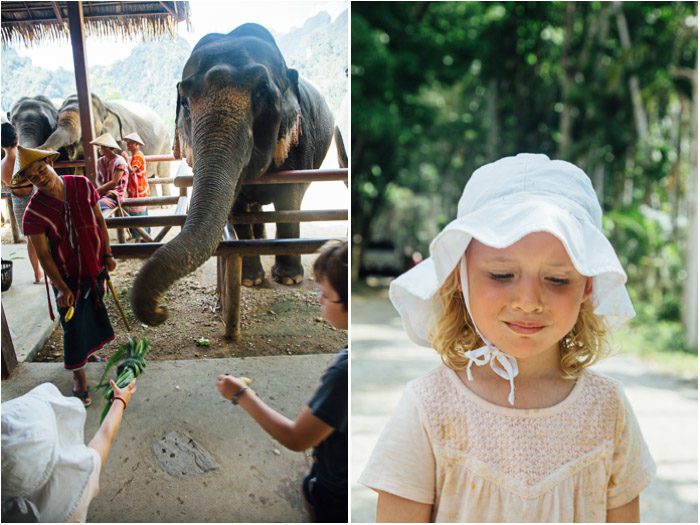
When it was time to go and they walked back out into the field, Skyler was so sad: “I want to go with them.” I think we all felt that way.
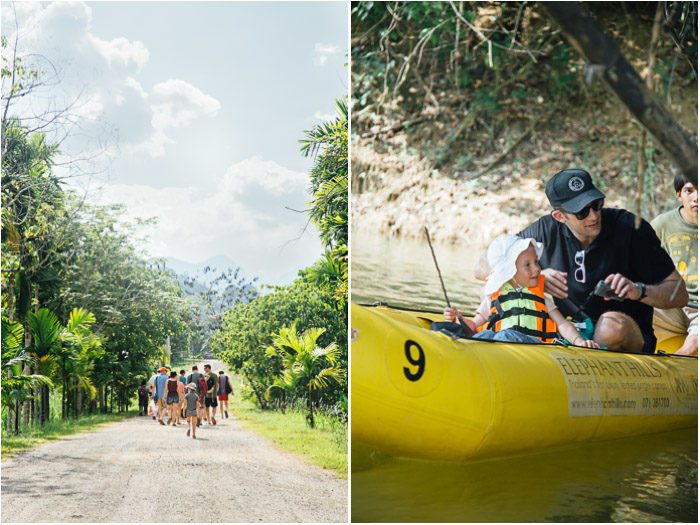
But we waved farewell and walked back down the road to the nearby Sok River where we each joined a paddler in an inflatable kayak for a ride down the river. Hudson collected figs that had fallen as we floated by, Skyler spotted giant frogs in the roots of a tree, and we took in a new view of the incredible scenery in a chorus of bird calls. At one point, we all stopped to crane our necks and try to train our eyes on a troupe of macaques on the hillside. At first I could only make out movement in the tree-limbs, but eventually I caught a glimpse.
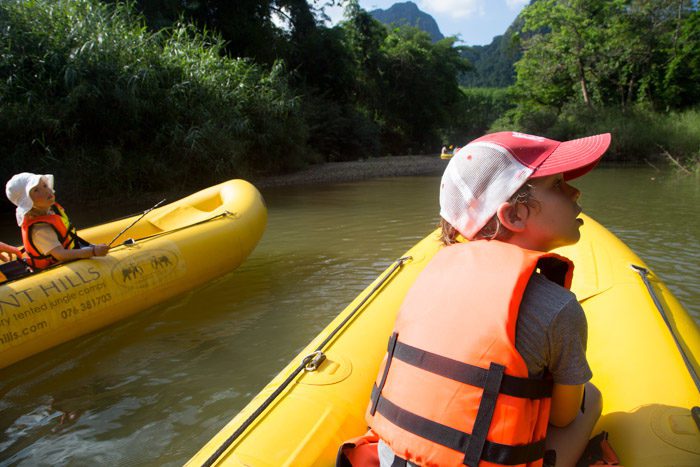
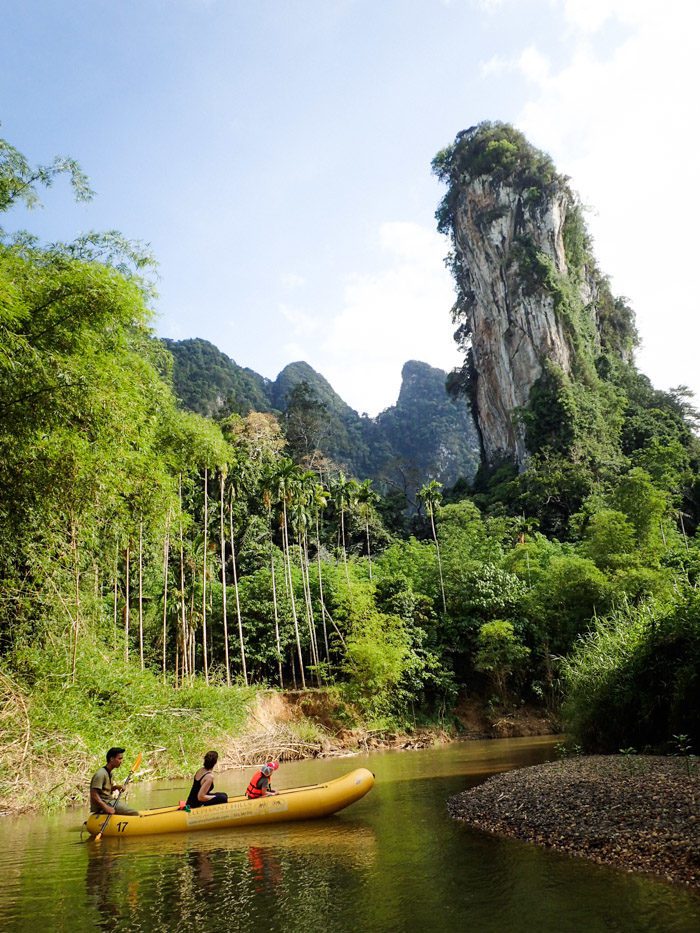
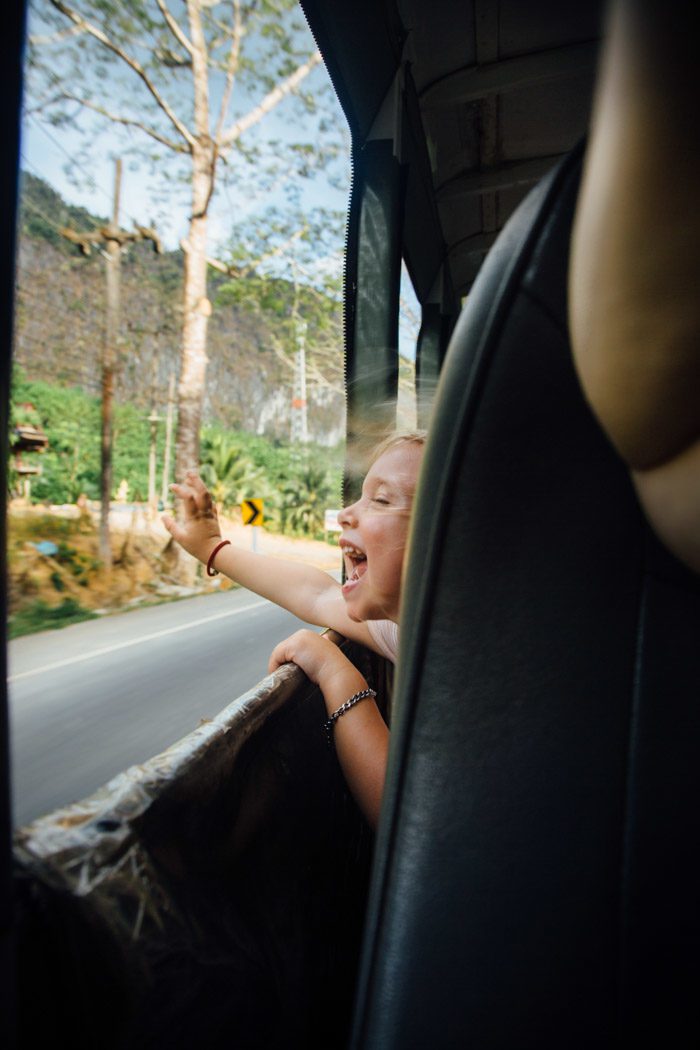

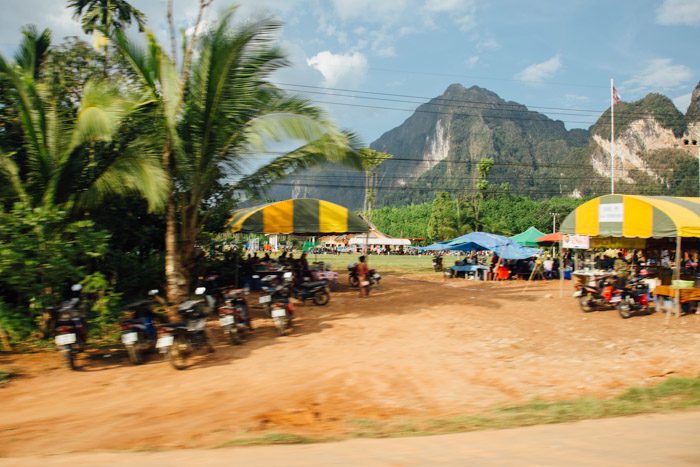
The drives to and from camp each day could feel a bit long (30 minutes to an hour, usually), but there were lots of things to see. Rubber trees dotted the land in between huge swaths of jungle, and crowds gathered on fields for soccer games and food stalls. As it was unlikely that this area was well-covered in any guidebook, it struck me as the perfect place for someone to get around on a motorbike and make impulsive stops.
Apparently there is one book called Waterfalls and Gibbon Calls that is tailored to self-guided hikes in the region, but its quite a few years old.
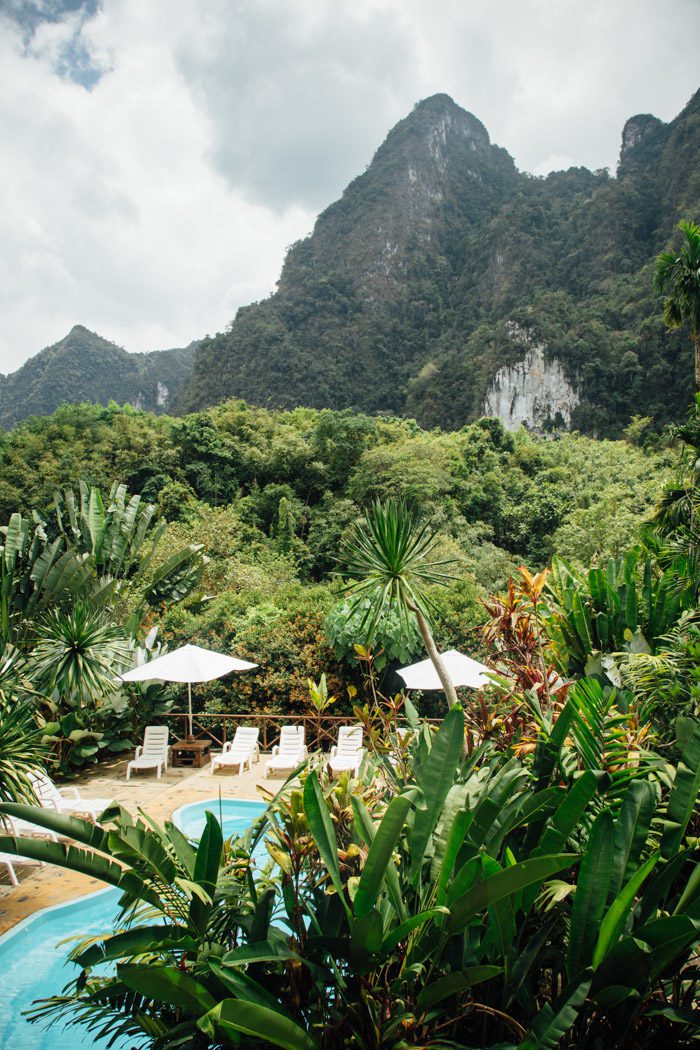
After the excursion, we grabbed some cocktails from the bar and donned our suits for a swim before dinner.
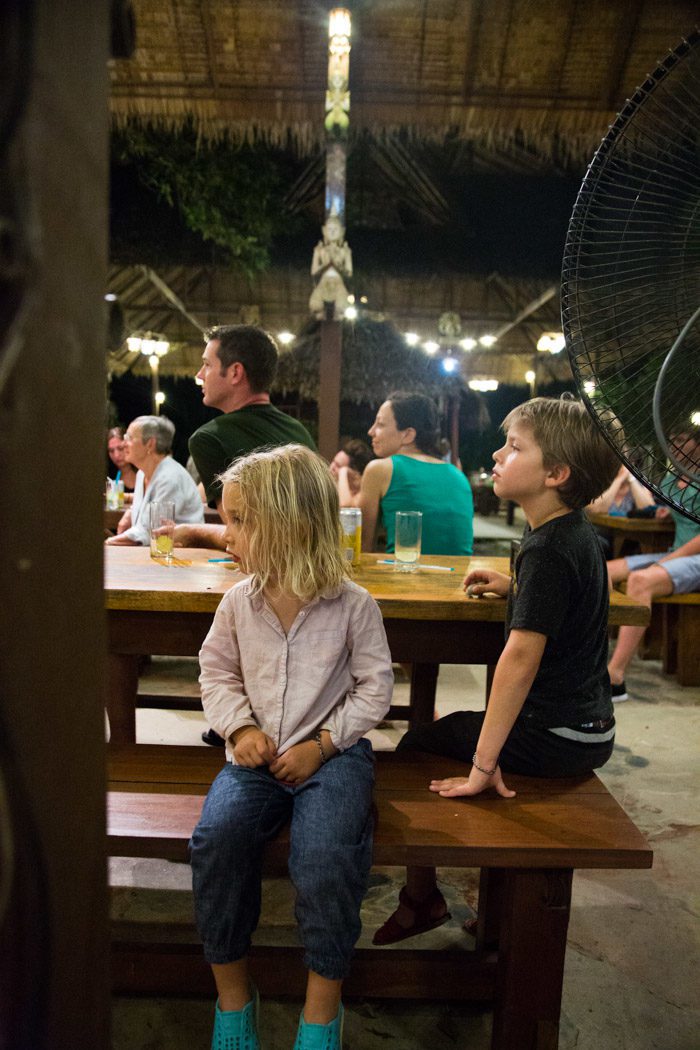
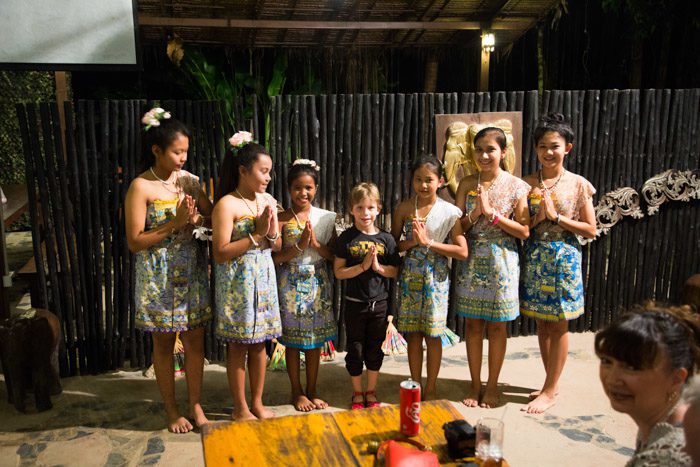
The evenings were quite late for us. Our kids were able to stay up, but we were well aware that we could have tucked them in around the time that each evening’s activities were just beginning.
Every night they show a short film in the main building (not a must-see), and then a different group of school children from a local school visits to put on a show of traditional dances. I think the fact that they were children was really impressive to Hudson and Skyler, who sat rapt the entire time. “They’re amazing!” Hudson exclaimed, as Skyler gave me her crooked smile and a thumbs-up. After the first night’s performance, they asked if anyone wanted to come up and take a picture and Hudson raised his hand. I think he was the only one who did, but he didn’t know that. Afterward he whispered to us, clearly flattered, “why do you think they picked me?”
Then there was a short cooking demonstration. One night we learned how to make pad thai, another we got instruction in green curry.
After a gong is rung, everyone is invited to the buffet. I wasn’t expecting much—buffets are often pretty average—but the food was wonderful. It had some items geared for western tastes (like French Fries and nuggets for the kids), but the Massaman curry was some of the best I can recall.
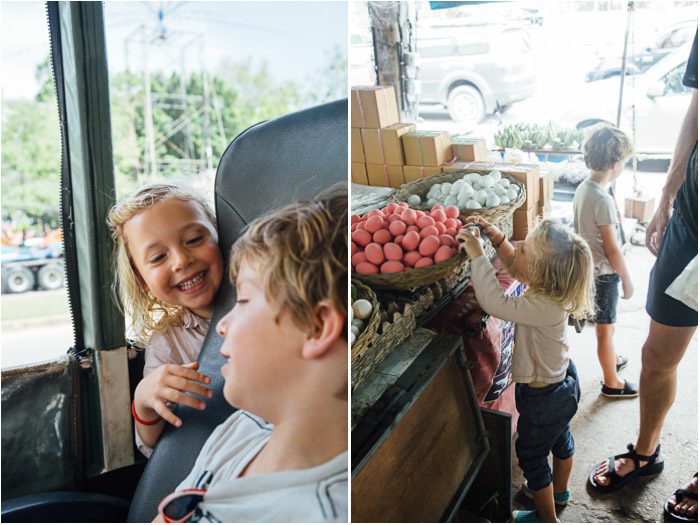
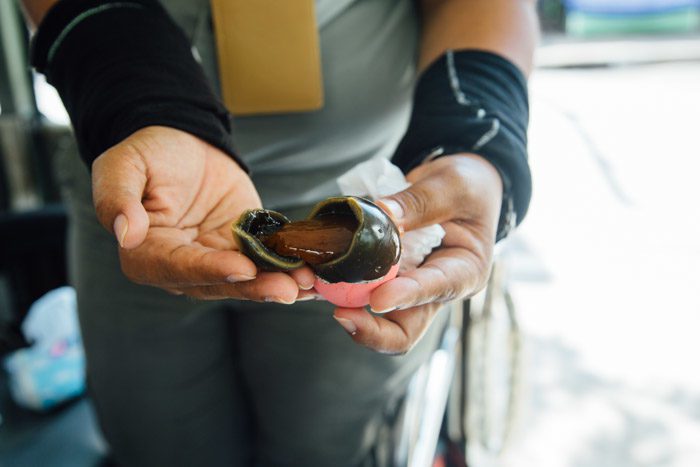

The next day, some of our group set out their suitcases for transfer to the rainforest camp, and we packed up a daybag for a visit.
The truck drove us out toward the Ratchaprapha Dam, stopping first in town of Ban Ta Khun near the park’s southeastern point for a visit to their local market.
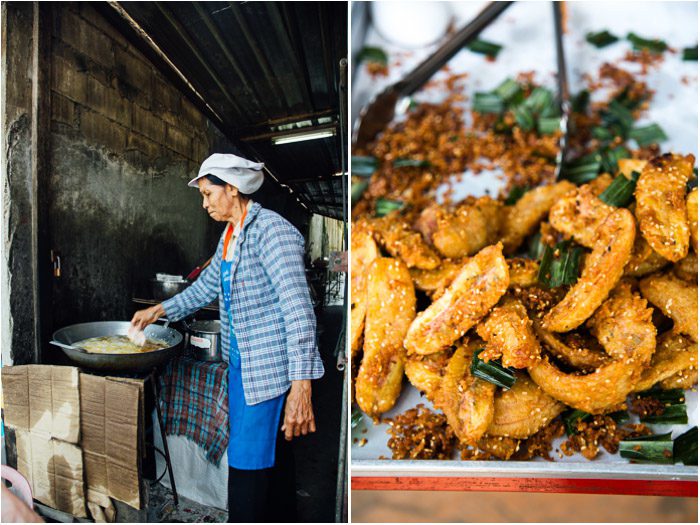
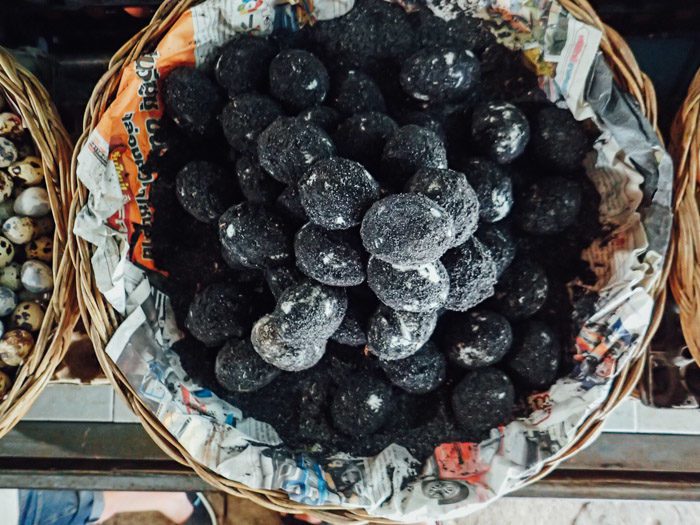
We picked up some fried snacks and wandered around to see what was for sale. Hudson will remember this as the market with the whole pig’s head and the pink eggs. Called “century-eggs,” we learned they are dyed pink as a way to mark them as having been prepared in a brine of salt and calcium carbonate solution. They smell horrible but taste good—if you can get past your nose. The white is changed into a kind of brown, umami jelly while the yolk remains rich and creamy and salty. Apparently they’re often prepared with sugar, salt, and fish sauce, served with chile and ginger over a bed of onion and coriander.
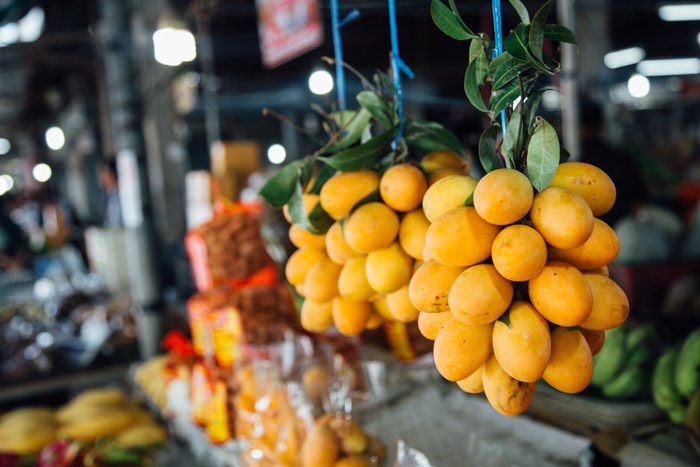
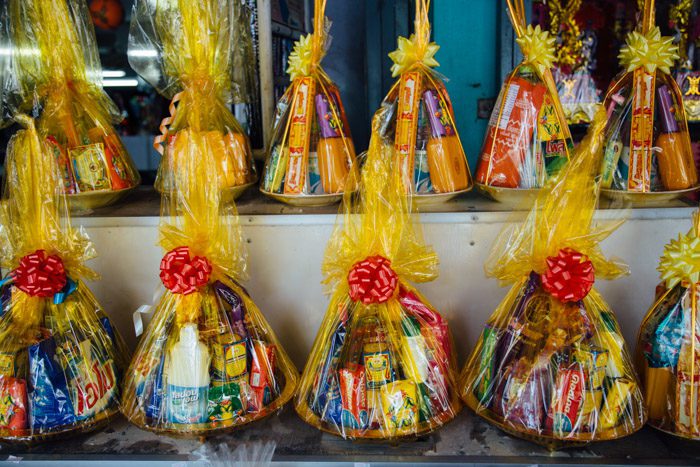
We sampled a variety of tiny mangoes and found baskets of offerings for the monks. There were also some shops selling clothes and other souvenirs for those interested.
Afterward, we drove onto the giant Rajjaprabha Dam for a quick look and rest stop opportunity. Cheow Larn Lake was created when the Dam blocked the Klong Saeng River in 1982, and a 64-square-mile basin was flooded for hydro-electricity. Families and animals were resettled (though it sounds like hundreds of the latter did die at the time from the habitat change).
From there, it was just a bit further to the pier for Cheow Larn Lake, where we boarded a longtail boat.
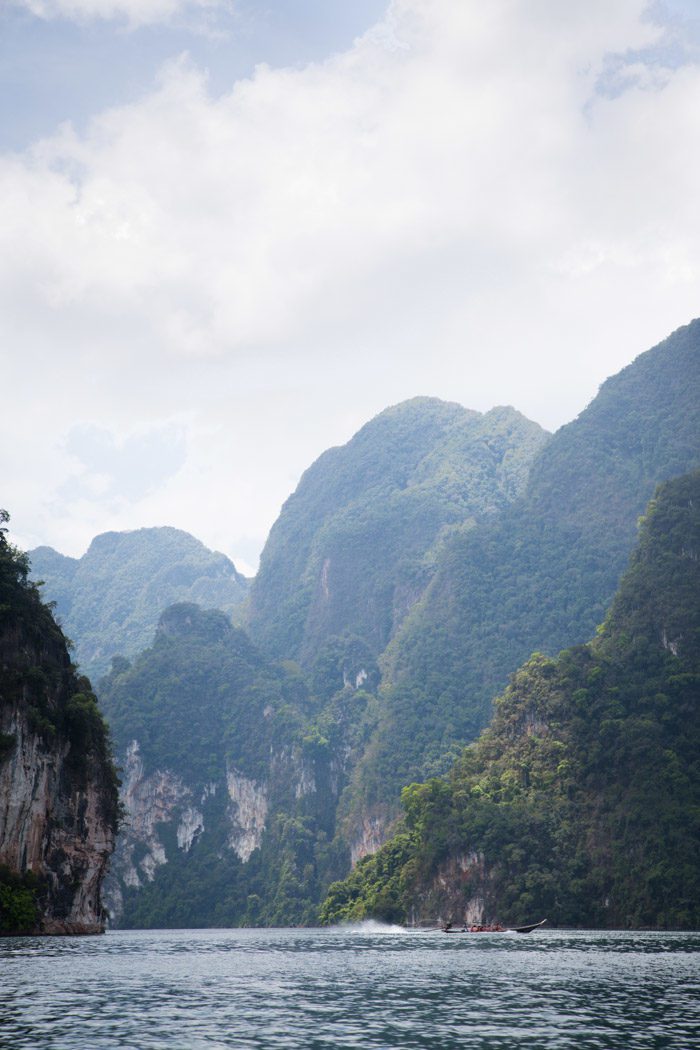
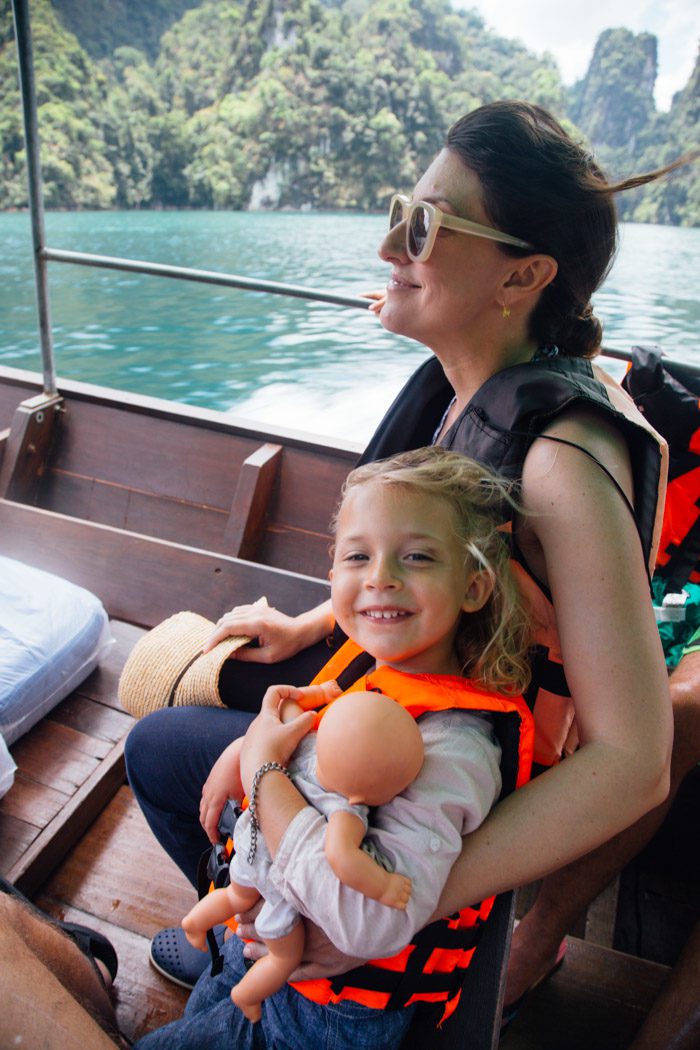
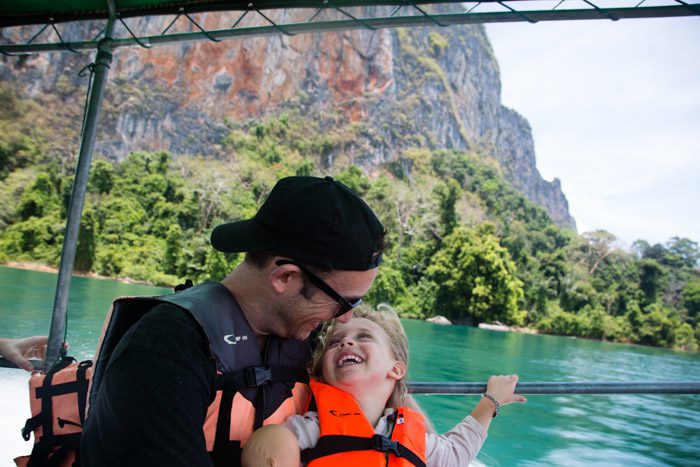
We sped along the emerald water, pausing to admire dramatic limestone karsts—some reaching 3,000 feet—that created islands on our way to the floating rainforest camp.
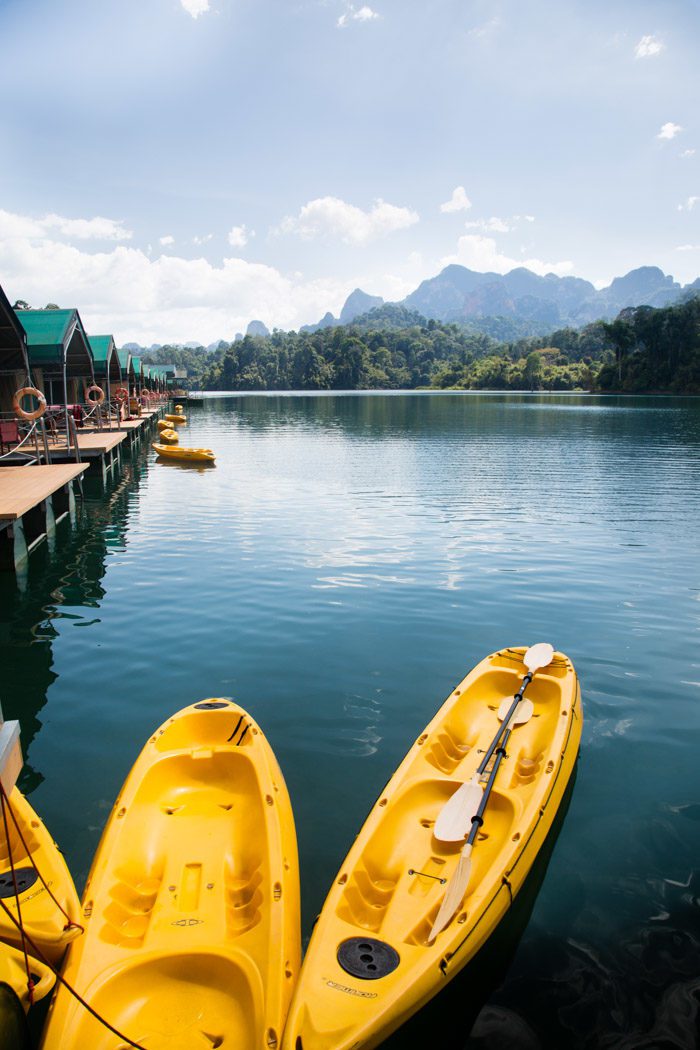
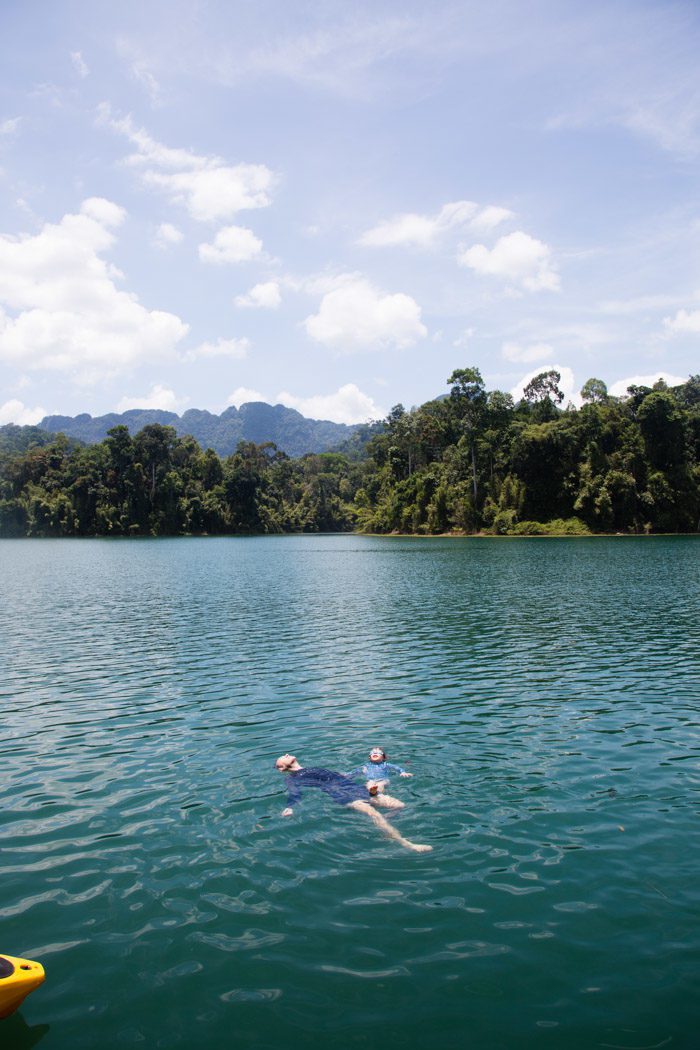
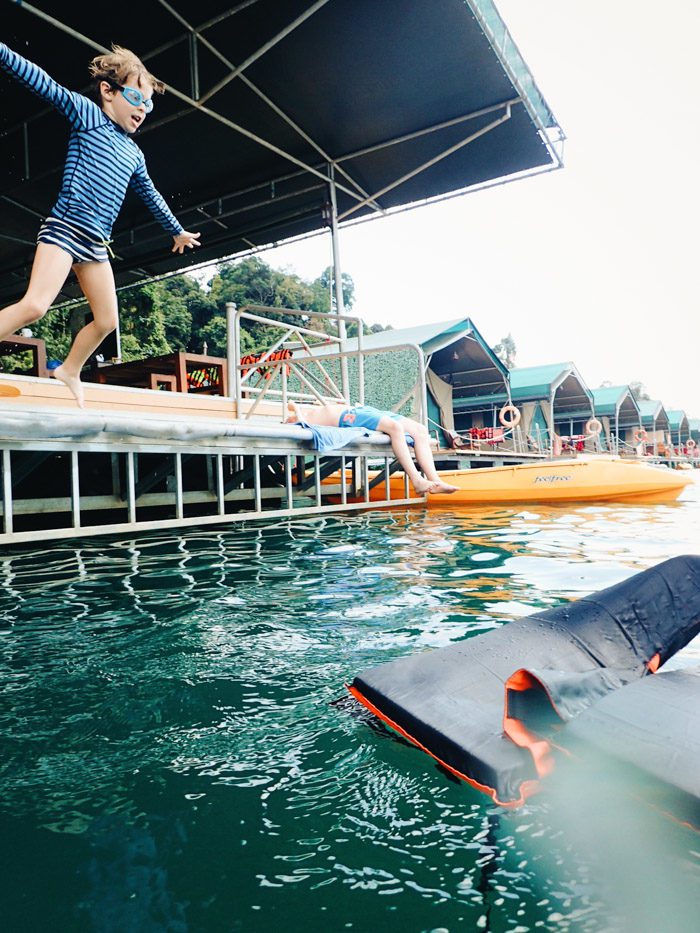
The water was cool and refreshing on such a hot day and we all jumped in immediately—and repeatedly.
Lunch was served soon after we arrived, and was followed by a few hours of free-time to use the kayaks, swim off the docks, and look around the trees for the monkeys that would every now and then disrupt the canopy. It was a wonderful afternoon with only one exception—my sunglasses are sitting somewhere at the bottom of the lake now (which can be as deep as 100 meters in places), accidentally knocked off the dock.
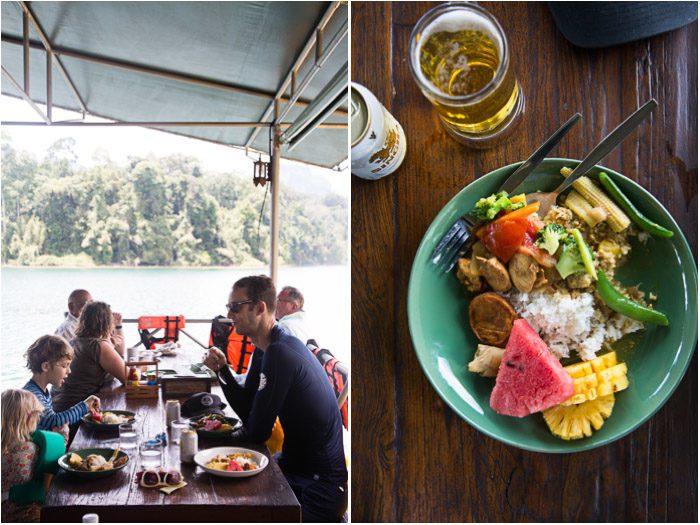
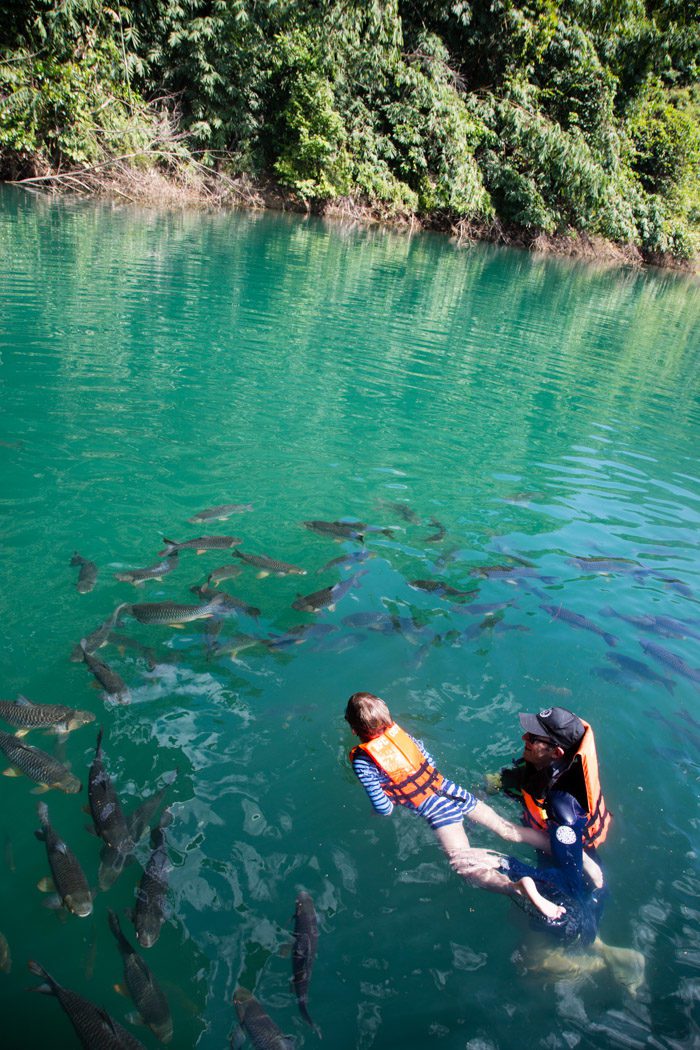
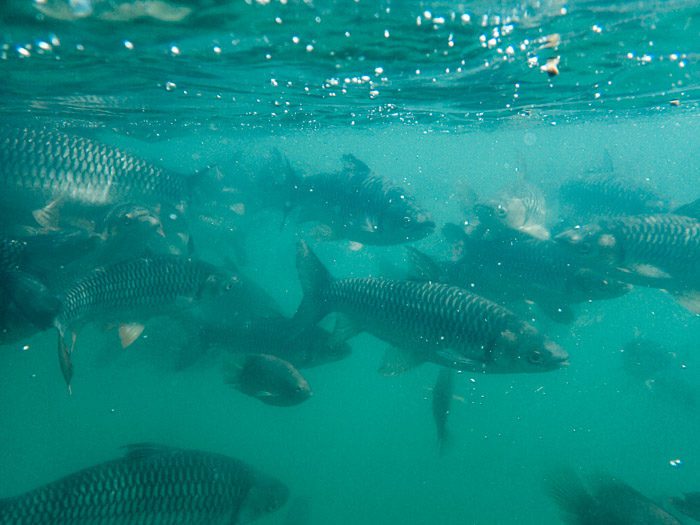
I was particularly impressed by Hudson who was one of the only two people to go off the backside of the floating cabins where the larger fish seemed to gather.
Those who stayed on for the night started to settle onto their own docks, reading, and awaiting sunset. I imagine the view just grows lovelier by the hour.


We caught some of the dimming light as we left the pier and boarded the truck and it was a beautiful ride back to camp. The evening proceeded much like the prior—with a short film, a dance by local school children, and a cooking demonstration before dinner.
That night, Skyler fell asleep at the table again, so as Aron carried her back with Hudson (spotting an enormous monitor lizard, with a tail as big as Skyler), I stayed behind for a head and neck massage.
And one thing had me in knots: my camera stopped working! While we were at dinner, Hudson and Skyler were finding all kinds of interesting insects (as usual)—a leaf-mimicking Katydid, a shiny green beetle that had landed like a brick on my arm—and the camera wasn’t focusing properly. Then it flashed an error message and that was it. We couldn’t use our SLR for the entire rest of the trip. I couldn’t believe it. What awful timing! We counted ourselves lucky that iPhones have such good cameras now, but it’s really not the same.

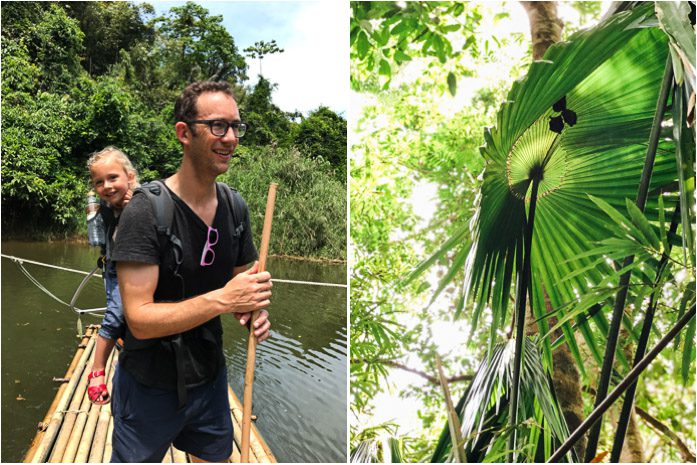
The next morning was our last. After breakfast—the highlight of which, for me, was yogurt with honey and fresh roti—we took a guided hike. Bamboo suggested it might not be ideal for the kids (perhaps too hard, too hot, and not much to see except the local flora), but we were sure they would be game, especially with Skyler riding most of the time on Aron’s back. As it turns out, Hudson might tell you that this was his favorite part of our stay—in part because we got to carry giant walking sticks and scramble over rocks.
We crossed a river behind the property on a bamboo raft, floating above tons of fish who are clearly used to getting a bit of food from its riders and eerily resembled piranhas, and started making tracks. The jungle was humid and sticky, and it’s true that we didn’t come across any wild elephants, but we did find some bats nesting under a palm frond, and some giant orb spiders. Small black butterflies flitted this way and that.
Perhaps the most thrilling part for me was listening to the sounds around us. The trees echoed with the calls of gibbons. It was incredible to hear them. They spend their time swinging high in the treetops and their calls can carry for miles—but these were definitely closer.
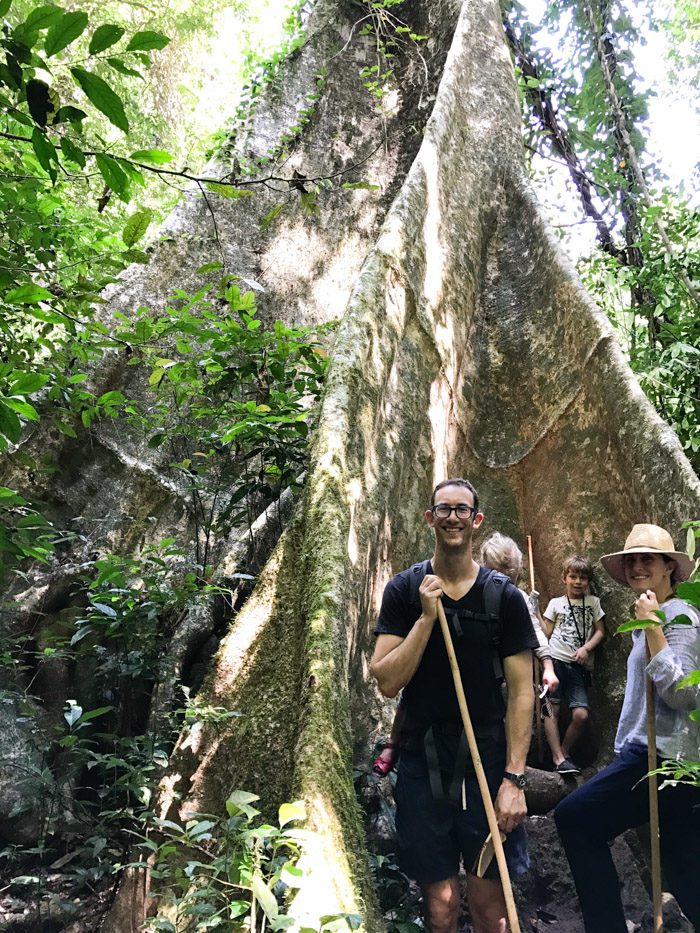

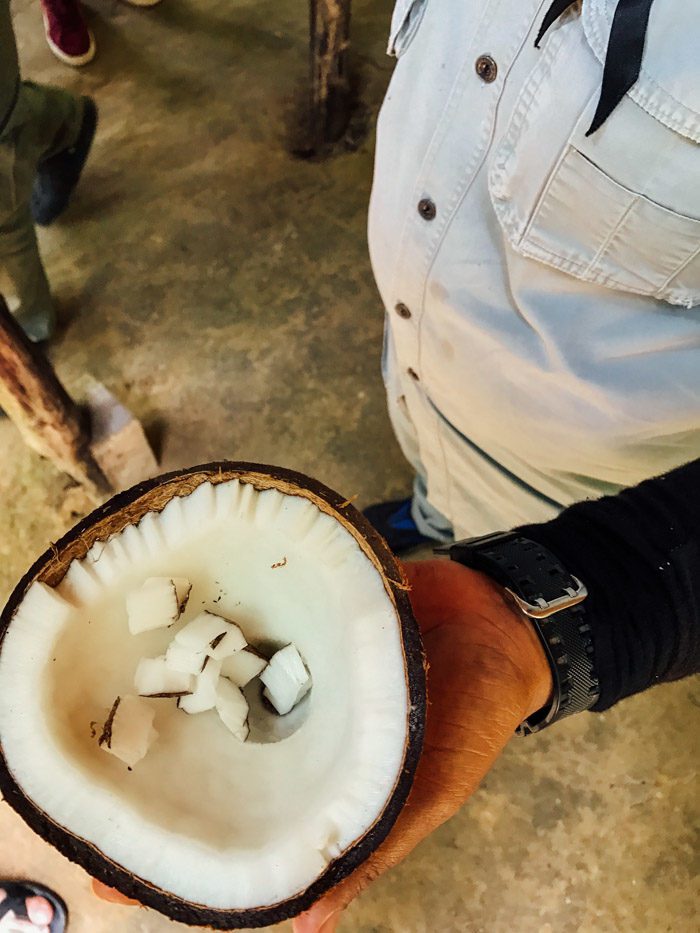
The group would be hiking out to a point where a camp was set up to make lunch before heading back, but we needed to leave a bit earlier than the rest of the group for our transfer to Phuket, so after stopping to see the preparations begin, we returned to the main camp for lunch with one of the guides. It worked out well: we had just enough time to clean ourselves up and refuel for the next leg of the journey.

We thought adding a visit to Khao Sok National Park hugely enhanced our time in Thailand. It was such a different experience than the one we had in Bangkok or on the islands, and it was a highlight for the kids who probably talk about what we saw here the most. It took a little settling into the feeling of the heat, the change to sleeping together in a tent (albeit a large one with an ensuite bathroom), the scheduled activities, and we did wish we’d had even more time to interact with the elephants, but we were really happy with the choice of Elephant Hills and would definitely return if given the chance.
Next up: Ko Yao Noi, and Phuket.
Previously: Bangkok (Part 1), Bangkok (Part 2)


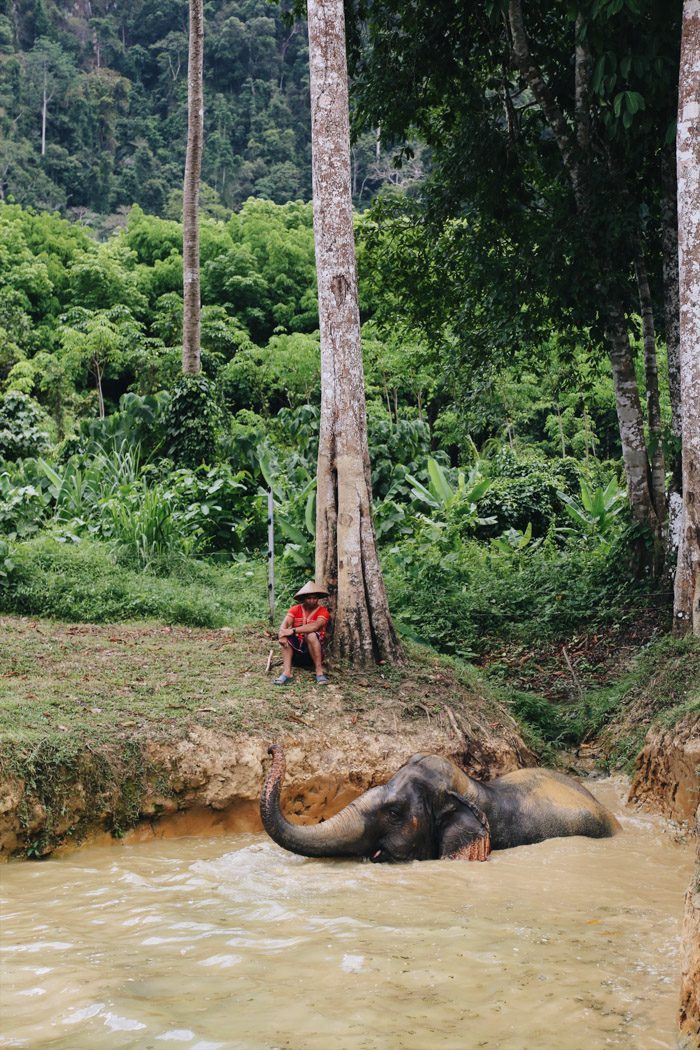
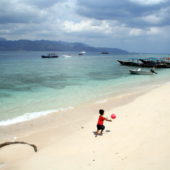
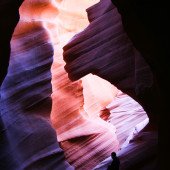
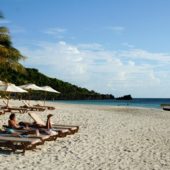











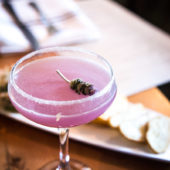
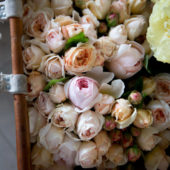
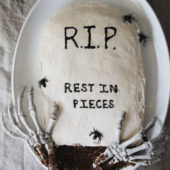


















17 Comments